Some popular aquarium fish have been obtained by humans as a result of long selection or crossing. Often, the resulting forms differ significantly from the ancestral forms in their color. This is exactly what happened with golden gourami – a beautiful color variation of spotted gourami.
General information
Golden gourami is a labyrinth fish that was obtained by breeders in 1970. It took a lot of time and work to highlight a persistent golden color, but the result exceeded all expectations: the fish began to look much more attractive, but retained the natural endurance of their ancestor.
Representatives of the group of labyrinth fish have a special organ – a labyrinth, with the help of which they are able to swallow and use atmospheric air for breathing. This allows you to survive in oxygen-poor water bodies.
An unpretentious look, simple to keep and breed. Good for beginner aquarists.
Appearance
Gourami golden has a tall, elongated body. The maximum size is 15 cm. The mouth is small, slightly extended upward. The dorsal fin is short and is a distinctive gender feature: it is pointed in males and rounded in females. The anal fin is very long and wide, stretching from the middle of the abdomen to the base of the tail, with yellow spots scattered over it.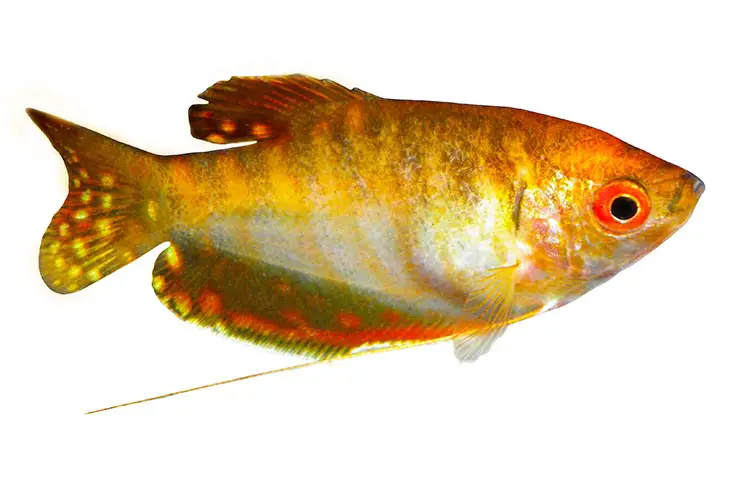
The pectoral fins are of particular interest. They have changed into thin threads, almost equal to the length of the body, and perform the function of the organs of touch: the fish touch the terrain with them in the direction of movement, new objects in the aquarium, and other fish when they meet.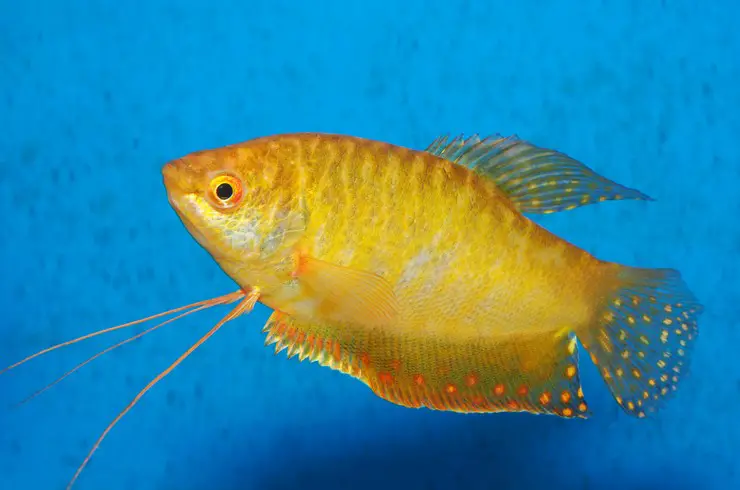
The body is colored golden orange, in the upper part there are dark stripes of various shapes. Two black spots (like blue gourami) may appear on the body – one at the base of the tail, the other closer to the middle of the body.
The average life span in an aquarium is 6 years.
Habitat
Golden gourami does not occur naturally. This is a complete aquarium species, bred by breeders. For sale come from amateur breeders or from special fish farms in Southeast Asia.
Care and maintenance
To keep adult gourami, you will need an aquarium of 80 liters or more, although young individuals can do with a smaller volume. The aquarium should be equipped with a cover to prevent the fish from jumping out. It is important to ensure that the air temperature above the surface does not differ much from the temperature of the water. Having “swallowed” too cold air, the gourami will catch a cold.
It is better to use dark soil, golden gourami looks much brighter on it. Natural driftwood, stones, and a large number of living plants act as decorations, among the thickets of which gourami like to hide. Several shelters are necessary because dominant individuals often chase weaker relatives. Golden gourami is diurnal and prefers to stay in the upper and middle layers of water.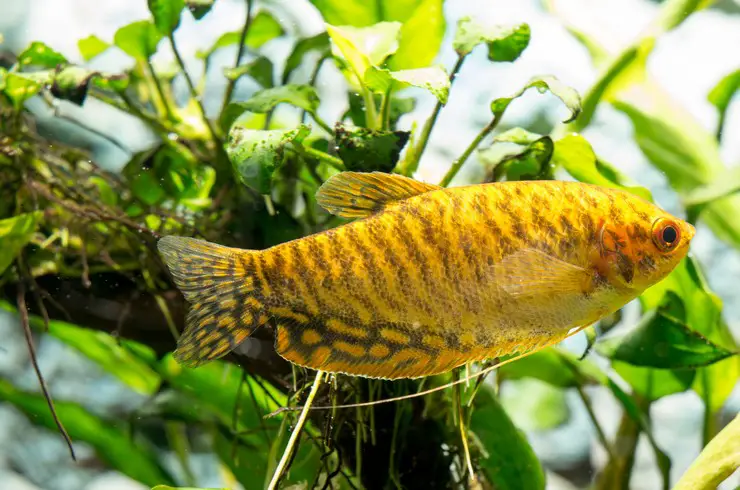
The lighting in the aquarium should be dim. It is necessary to provide effective filtration, but the compressor may not be installed if there are many living plants in the aquarium and there is no overpopulation. Golden gourami is a heat-loving fish; keeping in water with a temperature below 24 ° C is not recommended. The aquarium thermostat will help maintain the set temperature.
It is necessary to change up to 30% of the water in the aquarium weekly.
Compatibility
Unlike their close relatives, golden gourami is less accommodating with their relatives. Intraspecific competition for females can be very tough; in such conditions, the dominant male will not give rest to weaker individuals. Therefore, when keeping a school of fish, it is recommended that at least two females per male.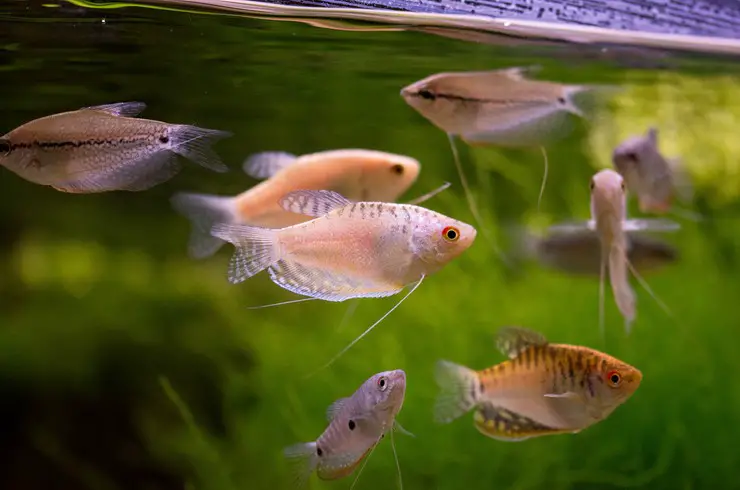
Golden gourami gets along well with other fish. It is important to exclude from the list of possible neighbors large and aggressive fish (large cichlids), as well as those who like to pick off fins from other fish (Sumatran barbs, goldfish). Do not forget that gourami are good hunters who are not averse to hunting the fry of other fish (especially viviparous ones).
Good neighbors will be rainbows, swordtails, minors, battles, catfish, tetras, and another gourami.
Feeding gourami golden
It is recommended to feed the golden gourami with high-quality dry food. Compared to live and frozen, such feeds have a number of advantages: they are safe (there is no risk of introducing infection and parasites), completely balanced, and created taking into account the nutritional needs of fish. You can use TetraMin, a universal flake food for all fish species, which contains more than 40 types of high-quality raw materials, as well as prebiotics for good digestion. It will be useful to enhance the natural color of fish with the help of natural carotenoids – they are found in large quantities in Tetra Rubin and TetraPro Color.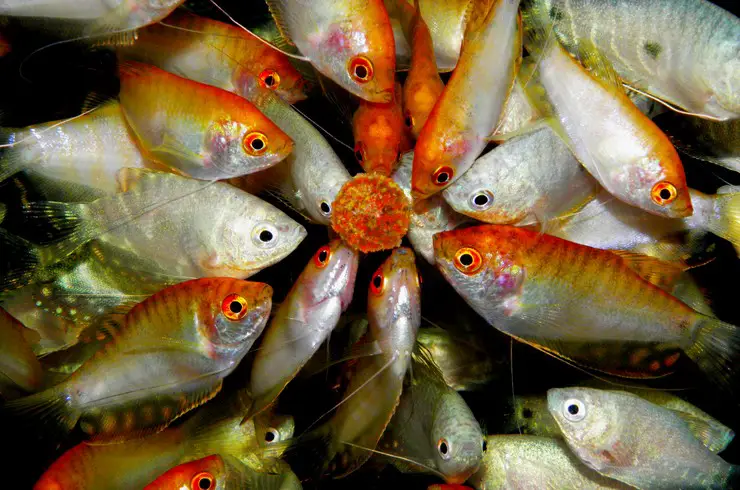
Golden gourami are quite voracious fish, so try not to overfeed them, but once a week arrange a fasting day.
A useful feature of golden gourami is their love of eating hydras in the aquarium. These coelenterates can be dangerous for small fish and fry because they sting them with stinging cells, but golden gourami will completely clear the aquarium of this scourge in a few days.
Reproduction and breeding
Reproduction of labyrinth fish is not difficult. It is necessary to select a good pair of breeders; you can distinguish between a male and a female by the shape of the dorsal fin. You will need a spawning aquarium with a volume of about 50 liters. The water level should be about 10-15 cm. There should be floating plants on the surface of the aquarium, such as Riccia, which will help seal the air bubble nest, which the male will begin to cook after being placed in the spawning ground. About a week before the expected spawning, producers should be intensively fed with high-protein feed.

